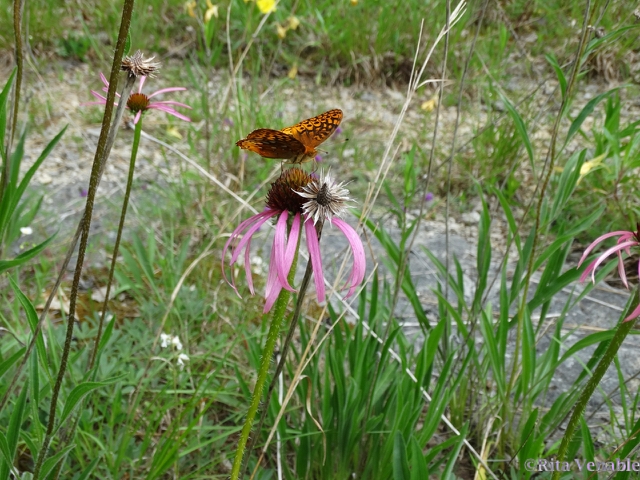I love a small discovery and here’s a new one—Prairie purple coneflower (Echinacea simulata) is a nectaring plant for the Great Spangled Fritillary (Speyeria cybele). This rare native plant was not listed in Butterflies Of Tennessee because at the time of publication, I had not yet found any proof of anything nectaring on it in Tennessee.
Last year in 2014, just after publication of the book, I observed this butterfly nectaring on prairie purple coneflower at a cedar glade in Rutherford County, TN. Notice the proboscis of the Great Spangled Fritillary probing into the flower. You can also see the limestone rock and the bright yellow blooms of Missouri Evening Primrose in the background. I highly recommend visiting cedar glades in the spring.
It appears that the dead stalk next to the flower is last year’s flower of the same species. Wildflowers Of Tennessee states that goldfinches feed on the seeds of these dead flower heads. Prairie purple coneflowers spread via rhizomes which are underground roots. The pollen is yellow distinguishing it from the pale purple coneflower (E. pallida) whose pollen is greenish white.
Usually, prairie purple coneflower blooms June–July. This one was photographed on May 31 illustrating the fact that plants do not always bloom according to our schedules! The Great Spangled Fritillary was a first generation for 2014 having spent the winter of 2013/2014 as a tiny, first instar caterpillar that had not eaten. In the spring, the caterpillar fed on violets, spent time in the chrysalis, and then emerged as an adult ready to feed and mate. Notice how colorful and complete the wings look—no torn edges or v-shaped bird bite marks and the wings are not faded with age. In the butterfly world, this individual would be described as “fresh.”
The prairie purple coneflower and the Great Spangled Fritillary should both be out and about soon in Tennessee. I hope you get a chance to enjoy both this spring.

